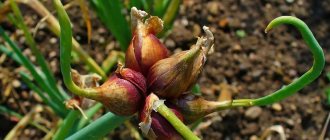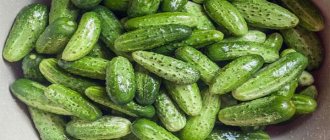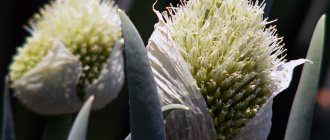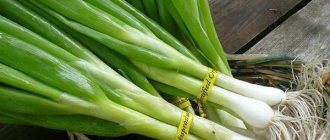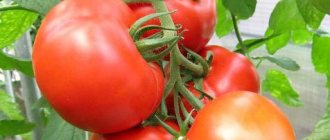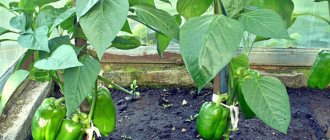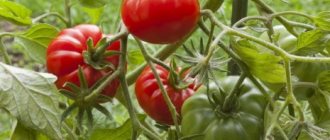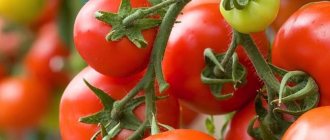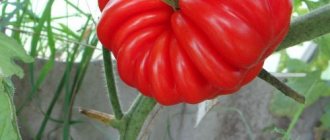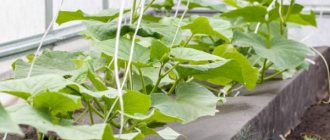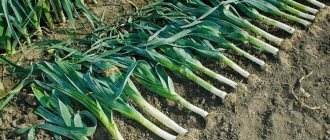Leek cultivation
Leek
- a biennial plant with a height of 40 cm to 1 m. In the first year, a root system with a false white bulb up to 12 cm long and up to 8 cm in diameter is formed. In the second year, a peduncle up to 2 m long with white or pink flowers develops, the seeds ripen in August -September. Seeds remain viable for two years.
Leek
grown from seeds and seedlings. In the southern regions, seeds are sown in open ground. In the northern and central regions it is grown from seedlings. Leek is a cold-resistant crop that requires moisture.
Predecessors of leeks
Leeks grow well in areas where legumes previously grew: beans, peas, soybeans and others; white cabbage, tomatoes, green manure, potatoes. Do not plant in an area where any type of onion grew.
Sowing leek seeds in open ground
Leek growing season
about 6-7 months, so seeds are sown in open ground to obtain salad greens at the end of July.
Sow seeds in the second half of April in shallow furrows, the distance between which is 20-25 cm, and between plants 15-25 cm, depending on the variety. The temperature should be 8-12 degrees at night and 20 degrees during the day.
Before sowing seeds, they must be treated (disinfected), especially for those collected in your own garden. First, place it in hot water (40-45 degrees) for several hours, then lower it into cold water.
To obtain quick germination, the seeds are still germinated. Moisten a cloth with water and place the seeds on top. Leave the seeds in a warm (20-25 degrees) place for 2-3 days.
Dry the hatched seeds for several hours so that they crumble and can be sown and sown in the ground.
If you use purchased seeds, there is no need to process them; sow them directly into the ground.
Video - Planting leeks in the ground
Variety selection
The choice of leek variety is always important. But we won’t be talking about the colorful pictures on the seed packaging. You don't always get the result from the picture. The fault is often the summer resident himself; he does not always take into account how suitable the variety is for his region. Although advertising is not always honest. For example, for the Vesta variety, the limit and even a record will be the following parameters: the leg is 50 centimeters, but the weight is 350 grams.
An early ripening variety will help you collect leeks from the garden as early as possible, but a late variety will give you the opportunity to enjoy the onions longer. Photo used as illustration. Source: Yandex.Images
In general, depending on the time of ripening, leeks can be divided into three large groups:
- early ripening varieties;
- mid-season;
- late ripening varieties.
Details about each of these branches and the advantages of each type.
Early ripening
For vegetables, it is customary to consider late varieties to be the most productive. Only this rule does not apply to leeks. Its early varieties, on the contrary, will give an abundance of fruit. Moreover, you can enjoy them not only at the beginning of autumn, but also at the end of summer. These varieties usually take about 140 days to mature . This species is good to grow in the south because it does not tolerate cold weather. The fruits themselves are not too large and the diameter of the stem does not go beyond 3 centimeters.
Mid-season
Maybe mid-ripening varieties are not ready to fight the numbers of early-ripening varieties, but the quality of mid-ripening vegetables will be significantly superior. The time for harvesting this variety falls in September; it needs an average of 160 days for the growing season .
It is mid-season varieties that have the most varieties. Photo used as illustration. Source: Yandex.Images
You can leave one of the mid-season varieties to overwinter in the garden.
Late
These are the most frost-resistant varieties. But their ripening time is long and averages 200 days . This is not enough and gardeners are ready to transplant onions for growing into special boxes and even grow them in a greenhouse.
Important! It is important to select leek varieties depending on the region.
Sowing leek seeds for seedlings
To speed up the ripening process, leeks are grown in seedlings.
.
In early March, seeds are sown for seedlings at home. Sowing seeds in a greenhouse is carried out in mid-April; when grown in a bed under a film, they are sown at the end of April. The soil should be light, turf-humus.
Dishes for planting, cups and other containers must be disinfected with a strong solution of potassium permanganate. Leeks have long roots, so containers should be up to 10-12 cm high.
Fill the containers with soil, lightly compact them, and water. Sow the prepared seeds (see above how to do this) and sprinkle with sand in a 5 mm layer.
Cover all containers with glass or film. Move to a warm place with a temperature of 22-25 degrees until germination.
Ventilate and spray the crops with water daily.
Diseases and pests on seedlings
When the plant is young, it does not have strong immunity. Therefore, even at home, leeks are susceptible to infection and attacks by pests. The first pest threat was the onion fly. Its larvae eat tasty greens. The insect can be brought in with the soil from the land plot.
Diseases that are often found on leeks:
- rust and black leg;
- downy mildew;
- neck rot.
The culprit of the infection is the farmer himself, who uses cold or unsettled water. Excessive moisture leads to rot and the appearance of blackleg.
You can avoid the occurrence of diseases and pests using preventive measures:
- watering with salt water. Add 35 g of salt per 1 liter;
- treatment with fungicidal agents;
- use of Fitosporin.
Caring for leek seedlings
The first shoots appear after 10 days. It is necessary to apply the film and expose the seedlings to bright, diffused light in a room with a temperature of up to 18-20 degrees during the day and 10-12 at night. The leek roots should be warm; place foam under the containers. Water the seedlings with warm water, making sure that there is no direct sunlight. If the seedlings have sprouted densely, thin out.
First feeding
carried out when the seedlings grow.
To do this, prepare the following solution
: dilute 40 grams of superphosphate and 20 grams of potassium chloride and ammonium nitrate into 10 liters of water.
When to plant seedlings in open ground
Leek seedlings at the age of 50-60 days are planted in open ground. Before planting, leek seedlings are watered abundantly. During the planting process, the stems and leaves are trimmed by 1/3. Plant seedlings in the evening or in cloudy weather.
Soil for leeks
The area for leeks should be sunny, as far away from bushes and trees as possible. The soil for planting leeks is prepared in the fall by adding a bucket of humus, 1 teaspoon of urea and 2 tablespoons of nitrophoska per m2 of land. After which the area is dug up. Use liming on soils that are too acidic.
With the onset of spring, add 3 kg of humus or compost per m2 of land; there is no need to dig it up. Fertilizers will get into the soil when planting seedlings and watering leeks.
When to plant leeks in open ground
In the process of growing seedlings, they are hardened at 6-7 weeks, taking them out into the open air for some time. In the area for planting seedlings, make grooves 10-15 cm deep and 20-30 cm apart. Seedlings are planted in furrows at a distance of 10-20 cm from each other, it all depends on the variety.
Leek seedlings are lightly sprinkled with soil and watered abundantly so that there is no air left around the root system.
Features of growing seedlings
When growing leek seedlings, observe the following : watering regime, fertilizing, maintaining optimal temperature and normal daylight hours. Seedlings are picked from common boxes into individual cups and hardened a week before transferring them to open ground.
Watering mode
Leeks need frequent and abundant watering - 2-3 times a week . Young stems are too thin and weak, so watering is done carefully through a sieve or with a syringe under the root.
Spraying with a spray bottle moistens the stems and washes away dust.
Top dressing
During the growth period, seedlings are fed twice :
- two weeks after emergence;
- a week before transfer to an open area.
As fertilizers, use the ready-made Kemira-universal composition or mix the components yourself - dissolve 5 g of potassium chloride, 20 g of superphosphate and 10 g of urea in 5 liters of water.
Bird droppings are considered the best food for leeks . To prepare it, dilute 500 g of droppings in 10 liters of water and carefully water the seedlings at the root, trying not to get on the stems.
Temperature and light conditions
After the emergence of friendly shoots - this happens after 2-3 weeks - the containers are transferred to a cool place with an air temperature of +10...+12°C at night, +15...+17°C during the day. In such conditions, the seedlings are kept for a week. Then the air temperature is increased to +13...+15°C at night, +18...+20°C. In this mode, the seedlings are kept until their final transplantation into open ground.
The optimal length of daylight is 12 hours . When sowing early in late January - early February, it becomes necessary to illuminate the seedlings with a phytolamp; a budget option is LED lamps.
Picking and trimming leaves
When sowing seeds in a common container, mandatory picking is carried out in separate containers.
The strongest seedlings are selected, carefully dug up with a spoon and planted in a prepared container with moist soil. To form the correct bulb, soil is periodically added to the container.
To ensure that the seedlings grow strong, the stems are pruned every 14 days, maintaining the height at 10 cm. This ensures proper development of the root system and thickening of the stem.
Reference. After 30 days, the seedlings in common containers are thinned out, leaving a distance of 3-4 cm between them.
Hardening
A week before planting in the beds, the seedlings are taken outside for hardening . The containers are left in partial shade. The time is gradually increased, starting from 30 minutes and ending with 12-16 hours.
How to plant leeks before winter
Leeks are often planted with seeds before winter, directly into the ground. In the summer, the site is prepared, fertilized and dug up. In November, furrows are made 20 cm apart and seeds are placed 8-10 cm apart in the furrows. Keep an eye on the weather, if it is warm the leeks will sprout and be killed by frost in the winter.
Be sure to mulch the area with peat and snow when it falls. The more snow there is on the site, the better it is for the leek; in the spring it will not freeze until the snow melts and the frosts will pass.
Leek care
Carry out regular watering, weeding and loosening of the soil, pest and disease control.
Loosen the soil once every two weeks. To grow a bleached stem, and this is the main value of leeks, it is necessary to hill the plants 3-4 times during the entire growing season.
The first hilling is carried out in mid-summer, after which they are mulched with dry grass, straw, and dry manure.
Watering leeks
After planting seedlings in open ground, the plants are not watered for three days. Moisture is the main component of leek growth, so further watering is carried out once every 5 days, 10 liters of warm water per m2.
Feeding leeks
Before each hilling, it is necessary to sprinkle wood ash under the onion stems, at the rate of a glass of ash per m2 of area.
Over the entire period, you will need 3 feedings of leeks.
First
carried out 3 weeks after planting seedlings in open ground. Dilute 15 grams of potassium salt and 20 grams of ammonium nitrate in 10 liters of water. This is enough to water an area of 4 m2.
As for organic fertilizers, a solution of bird droppings diluted 1x20 with water or a solution of mullein diluted 1x10 are suitable.
Video - Growing leeks
How to plant correctly?
Before planting onion seedlings, it is necessary to prepare important components of this process. Seeds must not only be of high quality, but also properly prepared.
The soil for onions is no less important. Photo used as illustration. Source: Yandex.Images
Seed processing
Onion seeds are processed in any case. It doesn’t matter whether it is planted as seedlings or in open ground.
Important! The shelf life of leek seeds should not exceed 3 years.
You can prepare it by soaking it in warm water for 24 hours, then simply dry each seed. There are also special solutions for preparing seeds, for example “Rostok”. The last option is to keep the seeds in a thermos, where the water temperature will be 40°C (3-5 hours). Then rinse the seeds with cold water and dry slightly.
Preparing the container and soil
In order to plant seeds for seedlings, you can not only buy ready-made containers, but also create them yourself. A wide variety of jars and cups can be suitable for this. An excellent option for planting seeds in peat tablets. Onions need nutritious and light soil for quick and easy germination. In stores there are always many options for soil that is already ready for this vegetable.
You can prepare the recipe yourself using the following proportions:
- one fourth peat;
- one fourth of garden land;
- two quarters of humus.
Soil disinfection before planting can be carried out with a warm solution of 1% potassium permanganate.
Leek diseases and their control
Of the diseases, the most dangerous is mosaic - the aphid carrier of this viral disease. Longitudinal yellow spots appear on leek leaves.
Leeks also suffer from such fungal diseases
: rust and powdery mildew.
For powdery mildew
Oval spots appear, increasing in size over time, on the leaves of leeks.
Plants affected by these diseases become inedible.
Rust
manifests itself by the presence of bright yellow spores on leek leaves. Affected leaves dry out.
How to fight diseases?
It is necessary to treat the plants and soil in the area with a solution of copper oxychloride or Fitosporin.
Viral diseases are not curable, so agrotechnical techniques will help cope with the mosaic:
Weed and pest control; Maintain crop rotation; Seeds for sowing must be disinfected; Removal of infected plants; Growing leek varieties resistant to viruses.
Leek pests and their control
The main pest of leeks is the onion fly. The onion fly can cause irreparable damage to the crop.
In May you can already notice the pest; the fly lays eggs on the leaves and soil. After a couple of days, larvae appear, feeding on the center of the leek, and the plants wither and rot.
Fighting onion fly
To protect the crop from onion flies, the area is pollinated with wood ash.
or a mixture of ash and tobacco dust. For 1 m2 of land you will need 1 glass of ash or a mixture of tobacco and ash.
Treatment with ground pepper
, teaspoon per m2 of area after treatment, carry out shallow loosening of the soil.
The use of tobacco infusion has proven itself well. Dilute 200 grams of tobacco and a tablespoon of liquid soap in 10 liters of hot water. Leave to room temperature, strain and spray the plants.
To combat onion flies, a solution with ammonia
with a proportion of 2 tbsp. l. ammonia per 10 liters, water 3 times at intervals of 10 days.
Read the article:
Ammonia: use in the garden and vegetable garden
To be sure to get rid of onion flies, plant celery
.
Video - ONION FLY a simple way to fight
Harvesting and storing leeks
Harvest onions
necessary before frost sets in -5 degrees. Using a shovel, dig up and leave to dry for a while at the edge of the furrow. Then clear the stems from the soil, trim the roots and store them. Do not trim the leek leaves, otherwise the plants will quickly wither.
Store leeks
it can be done in different ways. When stored in a cellar with a temperature of -1+1 and a humidity of 85 percent. Equip a storage box, pour a 5 cm layer of wet river sand on the bottom, place onion stems vertically, and fill the space with sand. In this way, leeks can be stored for up to 6 months.
When storing in the refrigerator, cut the leaves and roots, put 8 pieces in a perforated plastic bag and store at a temperature of -5 degrees for 4-5 months.
You can also store leeks in chopped form. Cut the stems with leaves, pour them into plastic bags in a 5 cm layer and store them in the freezer.
Landing
Depending on the container where the seeds are sown, different planting rules apply.
It is more convenient to sow one seed at a time in a separate container. But it is more prudent to insure against poor germination and sow 2-3 at once. Photo used as illustration. Source: Yandex.Images
The depth should be on average about 1.5 centimeters. The distance between seeds is 4-5 centimeters. After the seeds take their place, you can sprinkle another 0.5 centimeter of soil. Next, cover with plastic wrap and place in a warm place (21-25°C).
